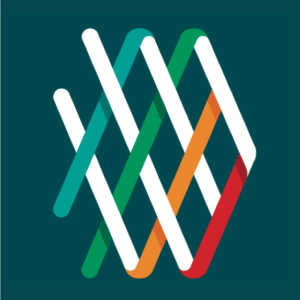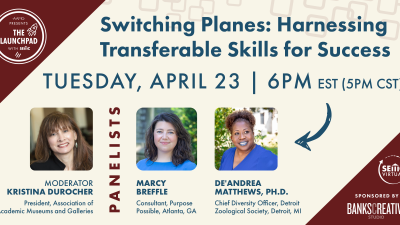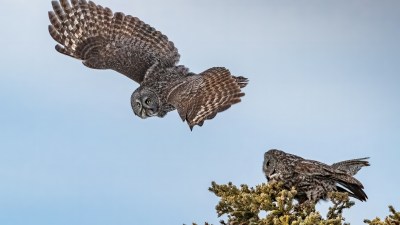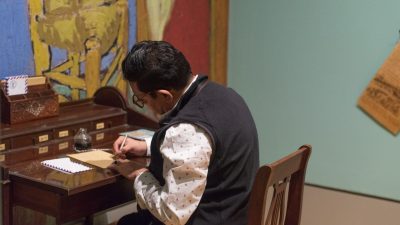This is a recorded session from the 2021 AAM Virtual Annual Meeting and MuseumExpo.
Hear from professionals at museums around the country who are trying to make their fundraising practices more antiracist. As museums face ever growing pressure to holistically live the values that they profess externally, fundraising is often a fraught topic. By exploring principles of community-centric fundraising, panelists will share examples of how they are leading this work at their museums.
Presenters:
Rehana Abbas, Principal, RKA Advisors, LLC
Emily Ironside, Director of Development, Crystal Bridges Museum of American Art and the Momentary
Amee Spondike, Deputy Director, Development and External Affairs, RISD Museum
Transcript
Rehana Abbas: Hi, everyone. Welcome. Welcome to our flash session today. We’re only with you for 30 minutes. So we’re going to dive right in as quickly as we can. My name is [Rehana Abbas 00:00:11] and I am an independent fundraising consultant. Most recently I was the chief philanthropy officer at the Oakland Museum of California. I want to quickly just acknowledge that I am in San Francisco, which is [Ramaytush Ohlone 00:00:24] land. And then I want to introduce my colleagues that are with me today. [Emily Ironside 00:00:31] is at the head of development at Crystal Bridges in Arkansas and [Amee Spondike 00:00:39] is at the RISD museum in Rhode Island. One thing I just want to point out as we’re having this conversation today, is that we all have come from very, very different museums geographically across the country and very different sizes. So one of our hopes today is that the things that we’re going to discuss are things that no matter your budget size or your location are things that we feel that you can take back to your organizations.
Just a quick bit of housekeeping. If you have questions, we are going to try to get to some questions, even though we have such a short amount of time. Please put your questions in the Q and A on your screen and then I will get to as many as possible. If we don’t get to all of your questions or you want to follow up with one of us, please, you can find us on LinkedIn and you can reach out to us that way. And then also just, I would encourage everyone to introduce themselves in the chat and share where you’re coming from today. So with that bit of housekeeping, I want to just jump right in. So this session today really came together because anyone who’s been attending sessions during the conference knows there’s been a lot of discussion around the role of museums in social justice and racial equity and the movement that’s had really gained momentum in the last year.
And those of us who are in philanthropy and development, it sits in a really, kind of sometimes uncomfortable position because philanthropy is made possible by really kind of gross unequal distribution of wealth. And there’s this discomfort with the ideas that the idea that donors might be kind of creating a problem with one hand that they’re trying to solve with the other through their philanthropy. And yet museums are… In America, museums are very dependent on private philanthropy in order to survive. And so this is not an either or situation, we have to live in this sort of and both reality that the system is broken and we need to participate in the system to a degree in order for organizations to stay alive and to keep our staff employed. And so we are all three diving deep into this work in our organizations. And today we wanted to share with you, given that context, what are some actual changes that museums can make in the development office, as our organizations are striving to become more anti-racist organizations.
And so with that, I’m going to allow… I’m going to have my colleague Amee introduce herself, and then Amee, I will… And then Amee and Emily, why don’t you both introduce yourselves? And then I’m going to start with a question for Amee.
Amee Spondike: Sure. Thank you. So, I’m Amee Spondike and I am the deputy director of development and external affairs at the RISD Museum. The Rhode Island school of design is built on what is now called College Hill. It’s part of the ancestral homelands of the [Narragansett 00:03:30] nation, the only federally recognized tribe in Rhode Island. However, indigenous people from many nations near and far live, study and work in Providence today. And just a little bit of background about RISD Museum. It’s a large university art museum. We have about… we have over a hundred thousand objects in our collection with a near universal collection. This past year, we committed 70% of our acquisition budget to the purchase of work by under represented artists. We serve RISD and Brown along with many other colleges, city of Providence, state of Rhode Island, in Southeastern New England and like many old coastal cities in New England, there is a vast difference of wealth and poverty that we need to manage as we think about what art museums do and who they’re for.
Emily Ironside: Thanks, Amee. And I’m Emily Ironside, director of development for Crystal Bridges, Museum of American Art. And the Momentary which opened in February of 2020 and it was not the inaugural year we had anticipated for the Momentary, but the Momentary is a contemporary arts and performance space, that is a satellite to Crystal Bridges. And our location is in Bentonville, Arkansas in the heart land. Essentially Bentonville Arkansas is right, if you dropped a pin right in the middle of the United States geographically, there we are. And we are located in the ancestral home of the Osage, [Caddo 00:05:06] and Quapaw. And excited to be on this conversation today, but I’ll pass it back so you all could get going.
Rehana Abbas: Thank you. So Amee, this summer you shared with me a DEI plan that the RISD Museum was working on, that I thought was so impressive. And I wanted to ask you to just share a little bit about what’s happening at your museum with this group and how that’s impacting development practices.
Amee Spondike: Thank you. Yeah, it was a project that took several years and it was also a project that took the entire staff working on it. And I’ll talk a little bit about that in a minute, but how we in the development department have thought about it, is that stewardship is where we can really make a big impact. And how I call it is, show your work, so being accountable for all of the good intentions that are present in our anti-racist statement, how do we practice that? So part of what we’ve done is that… And that I suggest everybody does, is post your anti-racist statement on your website and make it really easily accessible so anybody can find it, do not dig it deep down in there. And post it, even if it’s not perfect, if it doesn’t feel done, if it’s not super designed. I know that goes against every fiber of our beings because we work in art museums and trust me, I work at an art museum that’s part of an art school, we want everything to be perfect.
Let go of that and let it be iterative. And that way you can also offer opportunities for feedback because these are supposed to be living documents. And we’re supposed to be able to grow with them. I have a 13 year old, so I’m very up on what’s happening because 13 year olds seem to know everything right now. So we get feedback from the public. We get feedback from students, sometimes it’s harsh, but it’s always helpful, so consider that. The other thing that I like to think about when I talk to my staff is, let’s make our goal to live up to our social media. So we all have social media that we put a lot of thoughts and prayers in when things happen, so let’s live up to that.
And how can we practice what we preach? So, stewardship is an opportunity to show those values. We don’t list our funders by amounts anymore. We only list our funders alphabetically. That’s something that has been found in a lot of [Quaker 00:08:03] communities and we are one of those, so that’s been really helpful. We don’t print any kind of honor rolls. We talk a lot about no longer naming spaces, we are talking about removing the named spaces from our website and only referring to the spaces by what’s in them to make it more accessible and more friendly to everybody. I think that we can all agree that the European painting gallery makes more sense than Smith family gallery. Look at your membership level language and question all the language in it, question words like exclusive. How we came to all of this is by having really difficult conversations internally.
They were hard, but they built trust and that’s how we created the document. We had to start with a place where we were all vulnerable and uncomfortable with that vulnerability. It’s not easy, especially for fundraisers to have those conversations because… And I’ll speak for myself. I prefer clear, productive, goal based conversations and these were absolutely not that, these were big, amorphous, emotional conversations but I learned a lot about myself and I learned a lot about how to question what we were doing. And it makes me better at having similar conversations with board members and volunteer leadership so that we can start to work with them on the difficult conversations around decoupling philanthropy from leadership.
Rehana Abbas: Great. Thank you so much, Amee. And then I wanted to ask… Over to you, Emily. I wanted to ask you, so you and I have talked, over the years we’ve known each other, we’ve spoken a lot about putting some stakes in the ground around diversifying staff, not only hiring diverse staff but retaining diverse staff. And I know this is something that you’re really passionate about and I’ve been really impressed with what Crystal Bridges has done around that. So can you share what some of the things that you’re doing at your museum are, to diversify the staff in your office and then also to retain those staff members?
Emily Ironside: Yes. I’m happy to. But I want to reiterate what Amee says, this is a process and we’re learning through this process. So I think for me, just continuing to view the fact that we have these conversations like we’re having today is a huge step. And to not devalue the fact that we still are figuring this out so thanks to who’s participating today and I’m thrilled that we’re having this conversation. But one of the things that we have realized within an institution and of course industry wide, in the museum industry, we know that there’s a lack of diversity within especially leadership levels of an organization, but really all levels of an organization. And so we felt being an American art museum, our job is to tell the story of our great country and history and all of the different narratives and identities that make up who we are.
And we can’t do that if our team does not also represent those stories. And so we put a stake in the ground back in 2017 that, it was a multi-year goal, but that 50% of staff at every single level would be racially, ethnically diverse. We’ve since expanded that definition to also include veteran status and ability. But we do have a significant focus on racial and ethnic diversity, even still within that. It’s not easy. That goal is highly ambitious. And I think it’s important to note the unique demographics of Bentonville Arkansas and our greater region. We’re a region of about 500,000 people. We’ve just exceeded 500,000 people a couple of years ago, and we are 89% white. So if you’re thinking about hiring and recruiting and retaining, you might wonder how in the world are you going to achieve 50%? Your demographics are 89% white.
So we know this is a multi-year goal for us, and it’s going to happen with intentionality. I can say that one of the tactics that has helped is that, along with the 50% goal for all staff at all levels to represent diverse talent, we are looking at what does our candidate pool look like? And so hiring managers are actually unable to move forward with an interview process until their final candidate pool is 50% diverse. And again, we’re looking at racial, ethnic diversity, ability and veteran status within that. And so that really puts the onus on us as hiring managers, also our people services department to aid us in that, to ensure we are reaching the broadest possible audience with our job openings. And there’s an acronym I like to use called GROW and I think that represents kind of where we are as an institution, where we are as a field.
We’re really just growing in this awareness and how we can make it work for us. But I think about GROW. G, gather your tools, gather your resources, your people, your peers, conversations like today, gather all of that you need, your DEI statements, your mission, your intentionality around this, because without all of those tools and all those resources in your tool box, I don’t know that you’ll be successful at diversifying your fundraising team. R, recruit and recruiting quite frankly, began yesterday. So don’t wait until you have an opening to think, oh, it’s time that I hire somebody, it’d be great to bring in a talent that’s racially or ethnically diverse. If you haven’t built a network of talent in your own life and all the way up until that point. So continuously, it’s a daily effort to grow that network, diversify your network.
It takes intentionality, it takes strategy. It takes time. But I think you’ll realize there’s awesome talent in fields like hospitality, political campaigns, event planning, sales and all sorts of fields that just have transferrable skills. We’re looking for people people, we can train them on the talent that it takes to be fundraisers. But if they’re people people, we know they have what it takes. The O in GROW, omit bias. So think about your job descriptions. Are they written a way that are inclusive? Are you removing exclusive language? Think about education requirements. I know in the museum industry, academia and education requirements often do play a role in hiring. Do they have to? So does this role really require a master’s degree? Does it really require bachelor’s or is job experience equivalent? And can we look at some other ways that someone might have built the skillset to make them eligible for this role and successful in this role?
And then think about your hiring process processes. Are your hiring managers equipped with the tools they need to make sure it’s an equitable process for all candidates? I also think about this idea of hiring for fit. Often, we look to hire for someone who fits within our team culture or organizational culture, but I caution that that is often a space where fit becomes unconscious bias. And so you are looking for someone who feels and speaks and seems like someone you would get along with, that you’re likely going to feel that affinity towards someone with their most like you. And so it’s really difficult to diversify your staff, if you’re looking for people who, if, for example, identify as white, if I’m looking for people that act and connect with me and are like me, I’m not going to be very successful at diversifying my team.
And then of course, walk the walk. So now, if you’ve done all of the job to build your resources, gather your tools, recruit, omit bias in your process, make sure once they are on board, that you’re walking the walk and you continue your efforts in DEI throughout the organization, but also within your fundraising. Make sure your onboarding process is built around employee success, create mentorship programs. Also, we’ve talked about support your staff because there are times that they may encounter unconscious bias or microaggressions in the workplace or with donors and so ensure that your team knows that first and foremost, you’re supporting your team and be willing to address those issues with donors if they arise. We’ve had some circumstances and it’s not easy, but it was the right thing to do and I’m glad that we took that step. And just continue to identify how issues of diversity inclusion and access and equity continue to play a role in your work.
And I think you’ll get there. So I could say with confidence, our team has grown. We’re a team of 12 and we have currently 42% of the development and membership team at Crystal Bridges are individuals and awesome talent who identify as people of color and three of those are major gift officers. It’s possible we have the only major gift officers of color in our region. I haven’t yet taken a pulse. We’ve all been kind of sequestered during the pandemic to see what talent may be emerging out there. But, I think our team is strong and dynamic and engaged. And a big part of that is because we are coming from different backgrounds and perspectives. And I’m so grateful for that, but it’s been years in the making and it will continue to take years to come.
Rehana Abbas: Thank you so much for sharing that, Emily. And I think it is true what you say, it takes time and you have to lay this really solid foundation. And I think it’s really great. There’s resources out there as well. I recently became involved as a mentor for our local association of fundraising professionals. Chapter’s doing a year long mentorship program for BIPOC fundraisers. And I think it’s great because anecdotally, I’ve seen a lot of people leave the field in the last year. And I think that’s really sad. And I think we need to, as a development field, do better at having these conversations and retaining kind of the future talent for museums and even beyond museums for all nonprofit, so it’s a really great model, I think that you’ve put out there so thank you.
So I wanted to just share a little bit about, I’m no longer with the Oakland Museum of California. I left at the end of May but wanted to just share a little bit about some things that we were doing at OMCA that made… I think is kind of moving the dial in this work as well. And then I’m going to be really quick and then I’m going to go to the questions that are in the chat. So if you have other questions, please enter them. So, one thing I wanted to just mention was at the Oakland Museum of California, we recently eliminated board giving minimums and this can be scary for some development people to think about, because you’re like, that’s guaranteed. And we did it. And we did it because at OMCA, it was really kind of setting a ceiling instead of a floor.
And it was not a super effective way to fundraise and then it was leaving out a lot of people that we really hoped to be on the board and creating these kind of awkward moments around knowing that someone might not have capacity, but there’s many other reasons that you want somebody to join your board. So I wanted to mention just a few things that we were doing at the museum, that was sort of ensuring that we were looking at a growing amount of trustee giving versus an attrition by making this change. And it really goes down to your good basic fundraising principles of prospect research, having really honest conversations with donors, being transparent about the importance of giving. There’s foundations, who they want to see that you have a hundred percent participation from your board before they make a gift.
And that can be a $75 membership, it doesn’t have to be a $100,000 annual gift and so, just really helping everyone understand that we are taking the approach, that we’re meeting people where they are with their philanthropy, but it means that in the… how we like to say it sometimes when we’re bringing trustees on board, you need to date people before you get married. And in that dating process, you have to really have some of these conversations and be really overt about it. I know I’ve been in situations where someone on paper has capacity, so you make assumptions around what they’re going to give when they’re on the board and then that doesn’t actually pan out. And so I think it’s been really great because by eliminating board giving minimums, we’ve actually been more transparent in these conversations as we’re onboarding people, and then we can do our projections more effectively.
So that’s just one thing that I think is a really important shift that… I know for each organization, it’s going to be harder to determine when that might be a direction you can go in and there might be a lot of work to do also internally with the board around getting people comfortable with that idea. But I do, I personally do think it’s a direction that I hope I see more and more institutions move towards in the field. So with that, I want to jump to some questions in the Q and A. So one question says, have you found… I think, Amee, this is when you were speaking, have you found as you’ve made changes, that there was pushback from donors as you moved away from prestige, recognition and exclusivity?
Amee Spondike: That’s a great question. You don’t know we haven’t because we did what Rehana suggested and we were really vocal about it. And so the people, especially people on my board that I knew would maybe have some trouble with this, we just talked to them about it. And nobody really pushed back. It’s interesting that I think that maybe we have these hangups because we’ve been taught in certain ways. And when you just change, I think people are willing to change with you so, no, we haven’t. I mean, there’s always somebody that’s angry, right? But it’s fine, it’s part of the fun.
Rehana Abbas: So I can say I’ve had a little bit of a different experience. I actually did have… So we recently at the Oakland Museum of California, we’re in the final weeks of an $85 million campaign and we only had a few donors that were interested in naming. And one of those donors, I kind of got the sense that it might just be that they’re doing it because that’s what they always do when they give a large gift. So through their philanthropic advisor, started a conversation around what’s their motivation for naming with this gift and is it something they really want to do? It sparked a really large conversation within that philanthropic advisory firm where they hadn’t been questioning at all. Wait, why are we always presenting names in front of… physical spaces in front of these donors to put their names on. And then it sparked a conversation within that incredibly philanthropic family about, well, why do they put their names on things all over the city?
And they all know their kids don’t want it. And so then they started thinking about it differently and they’re like, well, wait, can we still do programs or those are not cool either. It was just really kind of an interesting conversation we went down. In the end of the day, I do think they’re probably still going to do a physical naming, but this is where we’re not changing this overnight. And we were able to at least get that conversation started and get some people to start thinking a little bit differently about why that’s a given, so that was interesting but I have seen a little bit of pushback on it so…
Amee Spondike: Well, we probably have very different kinds of donors, right? I’m in a small town in New England and you’re in the heart of Silicon Valley, really. So I don’t even have a huge amount of people using donor advised funds. It’s just totally different, right?
Rehana Abbas: Right.
Amee Spondike: It’s like family foundations. It’s a lot of old money here.
Rehana Abbas: Right. Okay. So I’m going to jump to our next question. Are your organizations still maintaining delineated giving levels in your annual fund and just not recognizing people by giving level? Or have you done away with giving levels altogether?
Amee Spondike: We still have giving levels for membership, but for annual fund, we don’t. We just recognize everybody the same way and honestly, if you give a membership gift and that’s around the same amount as a certain kind of annual fund gift, we’re going to invite you to the same parties anyway, right? The difference between earned income and philanthropy shouldn’t be such a firewall so we’re just trying to make it a much bigger tent and celebrate more people at the same time.
Rehana Abbas: Great. Emily, anything you want to add about what you’re doing at Crystal Bridges?
Emily Ironside: Well, talk about communities and how some things can be sticking points. This has been tough for us because we are very corporate driven community. And so a lot of… 30% actually of our contributed income comes from corporations, which I know is on the high end for most museums. And certainly having a logo on a wall is important. They want to see that their logo is there with their competitor’s logo or their peer logo or their parent company logo. So we are diving into conversations. I think that’s where we are all growing here. So this is a conversation their team has begun. We don’t know how it will shake out, but at least we are now actively considering what does it mean to differently represent levels of giving. We don’t have actually dollar amounts on our donor wall, but yet there are different tiers clearly. And so right now, that’s a difficult conversation for us to move forward, but it’s something we’re exploring.
Rehana Abbas: Thank you. We just have a few minutes left. So one question here that was from Emily Robertson. Can you say more about how removing names from galleries or removing monetary levels in donor lists are anti-racist practices?
Amee Spondike: Sure. So to clarify, we kept the names on the galleries, we just don’t refer to those anymore, instead of in our marketing language or just internal that we don’t. How is that anti-racist? It’s anti-classist and so it’s one of those things where it’s like class and race comes together. And we’re very conscious of that in our city and in our museum because we serve such a diverse financial kinds of situations. And when we’re always putting wealthy old money names everywhere and everything in the city is named after three different families including an entire university, that starts to dig into people. And so lifting that away helps break down a barrier. Does that make sense? I suspect that Emily or Rehana can speak a little more about that.
Rehana Abbas: Yeah. I mean, one of the ways that I look at it is that fundamentally, we live in a capitalist system that enables some people to create wealth and other people have been systemically left out of that system. So in order to have your name on the top spot of a wall that’s listed by donor amount, there are people who have not been allowed over generations to accumulate wealth that would enable them to give away that amount of money. And it’s not valuing other things that people are contributing to your museum, like time or community partnership. And so by saying, we’re going to value the person who can give away the most amount of money, I mean, research will tell you that people who make less give away a higher percent of their income than the highest earners in this country, but their dollar amounts are so much bigger. Why are we putting them at the top, right?
So I think that’s where, for me, by not listing people by giving level, it’s an acknowledgement of all of that, that wealth at that level is created by a system that is fundamentally not equal and not providing equitable opportunities for people.
Emily Ironside: That’s a great place for us to wrap up. I think we’re at a minute here, but I mean, I think this is what we’re all exploring here today, right? I mean it’s complicated, it’s complex, it’s layered. None of us have all the answers, but I have faith and I have optimism that as long as we keep having these conversations, more and more best practices and tips to better do our work in fundraising, to align with all of our really amazing DEI mission oriented museums will be possible so…
Rehana Abbas: Great. Well, thank you, Emily and Amee for joining in this conversation. Thank you all for being here. I know it’s the very end of the day. I hope you’ve all had a great conference and that we can all see each other in person in Boston next year.
Emily Ironside: Thanks.
Amee Spondike: Thank you.









Comments